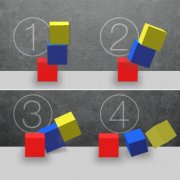Larry Hardesty | MIT News Office
December 13, 2017
Excerpt: "Josh Tenenbaum, a professor of brain and cognitive sciences at MIT, directs research on the development of intelligence at the Center for Brains, Minds, and Machines, a multiuniversity, multidisciplinary project based at MIT that seeks to explain and replicate human intelligence.
Presenting their work at this year’s Conference on Neural Information Processing Systems, Tenenbaum and one of his students, Jiajun Wu, are co-authors on four papers that examine the fundamental cognitive abilities that an intelligent agent requires to navigate the world: discerning distinct objects and inferring how they respond to physical forces.
By building computer systems that begin to approximate these capacities, the researchers believe they can help answer questions about what information-processing resources human beings use at what stages of development. Along the way, the researchers might also generate some insights useful for robotic vision systems.
“The common theme here is really learning to perceive physics,” Tenenbaum says. “That starts with seeing the full 3-D shapes of objects, and multiple objects in a scene, along with their physical properties, like mass and friction, then reasoning about how these objects will move over time. Jiajun’s four papers address this whole space. Taken together, we’re starting to be able to build machines that capture more and more of people’s basic understanding of the physical world.”
Three of the papers deal with inferring information about the physical structure of objects, from both visual and aural data. The fourth deals with predicting how objects will behave on the basis of that data."
Follow link below to read full article.
To read the three papers from "Advances in Neural Information Processing Systems 30" referenced in this article, see the following links:
Learning to See Physics via Visual De-animation
by Wu, Lu, Kohli, Freeman, and Tenenbaum
URL: https://cbmm.mit.edu/publications/learning-see-physics-visual-de-animation
MarrNet: 3D Shape Reconstruction via 2.5D Sketches
by Wang, Xue, Sun, Freeman and Tenenbaum
URL: https://cbmm.mit.edu/publications/marrnet-3d-shape-reconstruction-25d-sketches
Shape and Material from Sound<
by Zhang, Li, Huang,Z, Wu,J, Tenenbaum, and Freeman
URL: https://cbmm.mit.edu/publications/shape-and-material-sound

